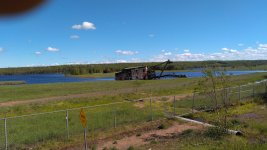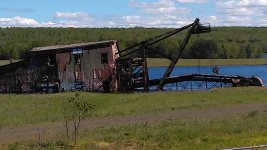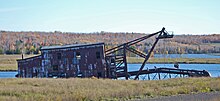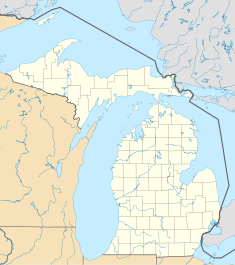I'm a sucker for looking at old abondoned derelicts, here's a old dredge down an inlet off the portage canal in the keweenaw peninsula. A more knowledgeable member can tell you what this dredge was used for.
Quincy Dredge Number Two
From Wikipedia, the free encyclopedia
Jump to navigation Jump to search
The
Quincy Dredge Number Two (previously known as the
Calumet and Hecla Dredge Number One) is a dredge currently sunk in shallow water in
Torch Lake, across
M-26 from the
Quincy Mining Company Stamp Mills Historic District and just east of
Mason in
Osceola Township.
[2] It was constructed to reclaim
stamping sand from the lake for further processing, and was designated a Michigan State Historic Site in 1978.
[1]
History

Bow of C&H Dredge #1 during construction

Dredge c. 1915, soon after construction

Dredge in 1978
The Reclaiming Sand Dredge was constructed for the
Calumet and Hecla Mining Company in 1914 by the
Bucyrus Company of
South Milwaukee, Wisconsin,
[3] and designated the Calumet and Hecla Dredge Number One.
[1] The dredge was used to reclaim previously-milled sand deposited in the lake after it had gone through the
stamp mill.
[4] The dredged sand contained
copper that earlier stamping technology had not been able to separate out.
[4] Improvements in stamping efficiency and cost increases in traditional shaft mining made these sand tailings economically feasible to reclaim and re-stamp.
[4]
Calumet and Hecla used the dredge at their Lake Linden Reclamation Plant until 1951.
[2] In 1951, the
Quincy Mine purchased the dredge and designated it as Quincy Dredge Number Two, using it at their own reclamation facility,
[2][4] which had been in operation since 1943.
[5] The mine's Quincy Dredge Number One sank in 1956, and Dredge Number Two was used until 1967,
[2] when it too sank during a winter lay-up.
[4] By this time, copper prices had fallen low enough that the reclamation process was not profitable, and the Quincy Mine abandoned both the dredge and its reclamation facility.
[4]
Description
The dredge is a large, box-like vessel that was used to remove sand from the bottom of the lake.
[2] The vessel has a steel hull measuring 110 feet (34 m) long, 56 feet (17 m) wide, and nine feet (2.7 m) deep.
[3] The decking overhangs the hull by eight feet (2.4 m) per side, giving an overall width of 72 feet (22 m).
[3] The dredge could process over 10,000 short tons (9,100 t) of sand per day, and had a 141-foot (43 m) suction pipe that could work in 115 feet (35 m) of water.
[2]
The dredge is currently sunk into shallow water, and canted over to one side.
[4] Most of the superstructure and the large boom are visible above the waterline.
[4]








